8 Insulation Products that Help Reduce Climate Impact
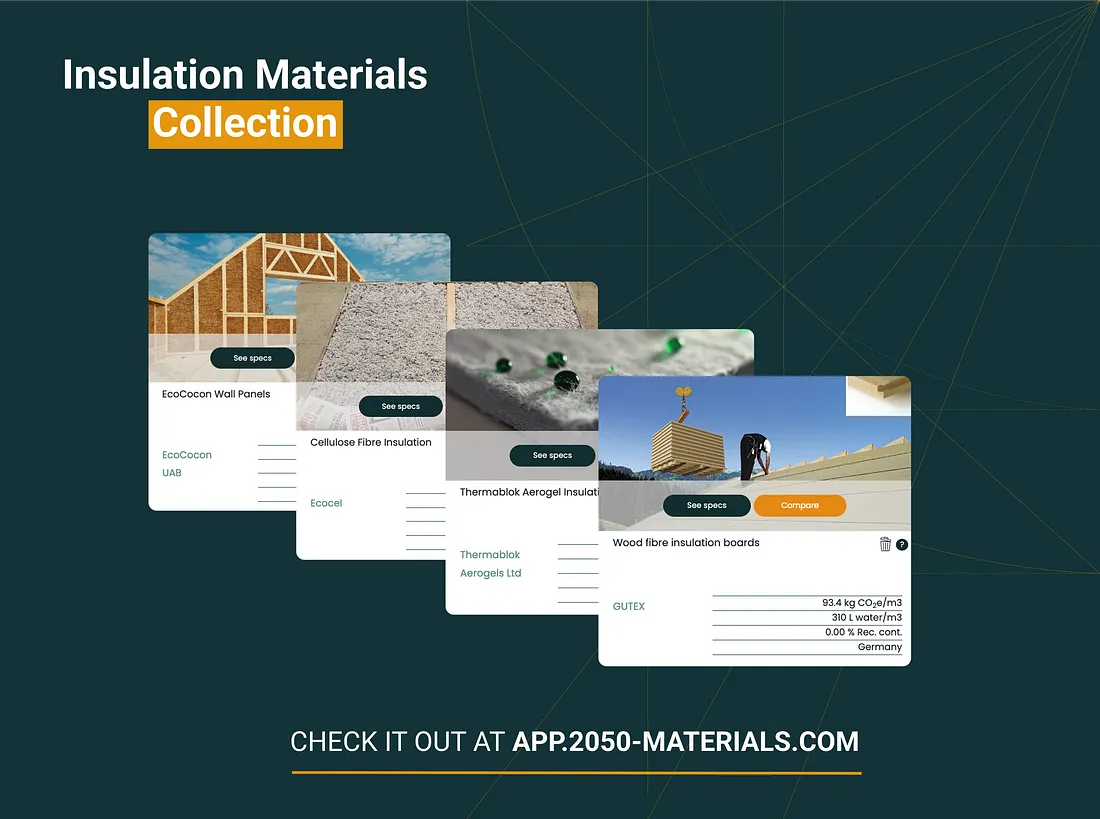
As the global focus on sustainability grows, the construction industry is increasingly adopting low carbon materials to reduce environmental impact. Among these, insulation products have gained significant attention for their ability to enhance energy efficiency while minimizing carbon footprints. This article and collection explores some of the most interesting insulation options available today, each contributing uniquely to a greener future.
1- Wood Fibre Insulation: Steico
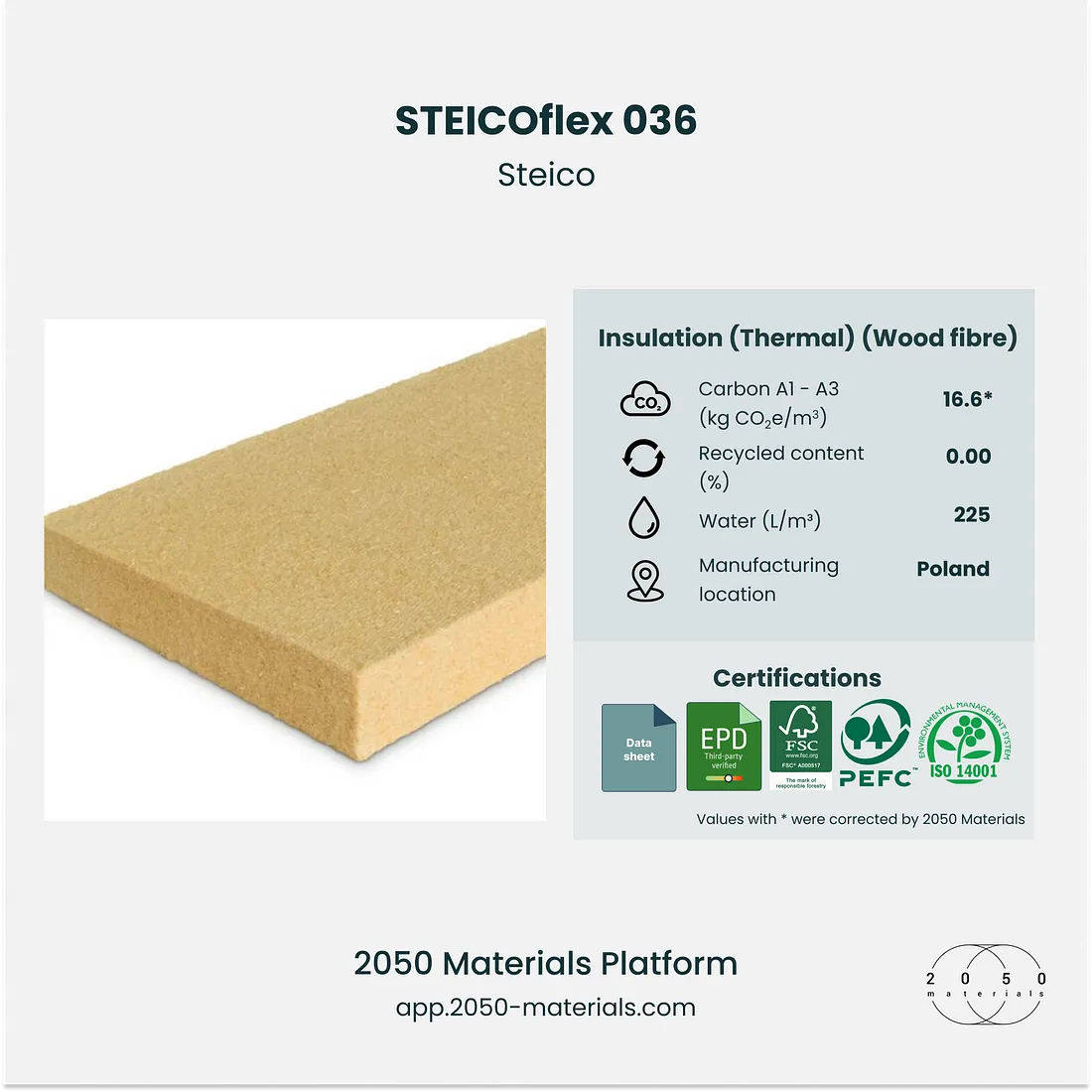
Sustainability Features
SteicoFlex is a versatile wood fiber insulation made from natural wood, a renewable resource that contributes to a lower carbon footprint compared to conventional insulation materials. The product is non-toxic, chemical-free, and biodegradable, making it a safe choice for both installers and the environment.
Advantages
– Made from renewable and biodegradable wood fiber
– Non-toxic and free from harmful chemicals
– Highly versatile and easy to install
– Regulates humidity, improving indoor air quality
– Recyclable and contributes to a circular economy
Use Cases
SteicoFlex is ideal for a wide variety of applications, including pitched roofs, attics, partition walls, service zones, drywall, and ceiling construction. Its self-supporting batts fit perfectly between stud work, whether installed horizontally, vertically, or at an angle. This makes it a popular choice for both residential and commercial buildings aiming for superior thermal insulation.
Explore SteicoFlex on 2050 Materials.
2- Sheep’s Wool Roll: Thermafleece
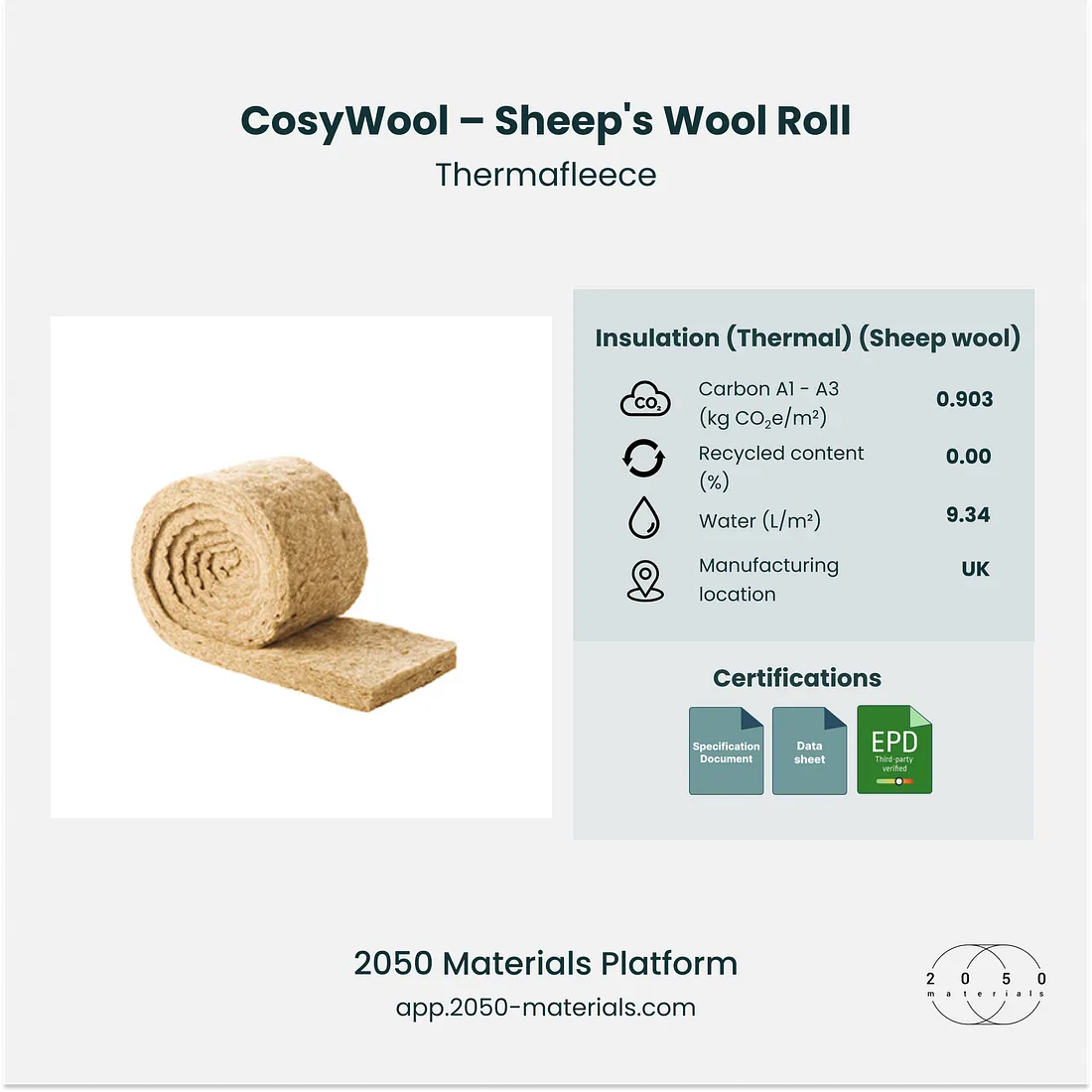
Sustainability Features
Thermafleece’s Cosywool insulation combines natural sheep’s wool with recycled fibers, offering a product that is and efficient. Sheep’s wool is a natural, renewable material with low embodied energy. It is also biodegradable, which ensures minimal environmental impact at the end of its life cycle. Additionally, wool’s natural ability to absorb and release moisture without compromising its thermal properties makes it an excellent choice for maintaining a healthy indoor environment.
Advantages
– Made from renewable and biodegradable sheep’s wool
– Provides excellent moisture regulation and acoustic absorption
– Low embodied energy, contributing to reduced carbon emissions
– Non-toxic and safe for indoor environments
– Biodegradable and easy to dispose of
Use Cases
Thermafleece Cosywool is perfect for use in roofs, walls, and floors, providing effective thermal insulation and acoustic absorption. It is particularly suitable for environments where moisture regulation is important, such as in humid climates or older buildings that require breathable insulation materials.
Explore Thermafleece’s Cosywool on 2050 Materials.
3- Aerogel Insulation Blanket: Thermablok Aerogels Ltd
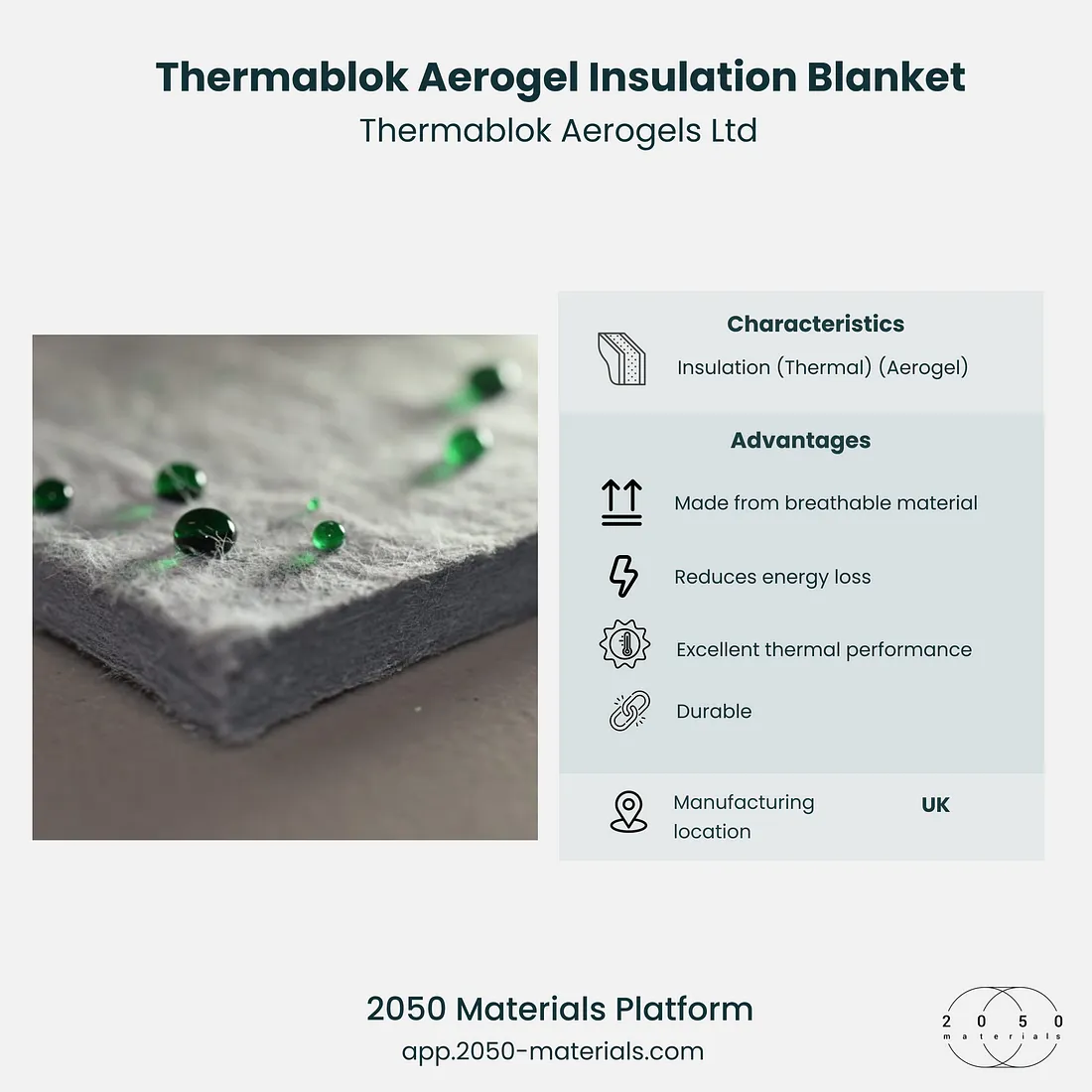
Sustainability Features
Aerogel is one of the most advanced insulation materials available, with up to 90% air content, making it extremely lightweight and highly effective at reducing energy loss. Thermablok’s Aerogel Insulation Blanket is a nanoporous insulation product that not only conserves interior space but also minimizes environmental impact due to its superior thermal performance, which reduces energy consumption. Its hydrophobic properties ensure durability and long-term performance, reducing the need for frequent replacements.
Advantages
– Extremely low thermal conductivity, enhancing energy efficiency
– Lightweight and space-saving
– Hydrophobic and durable, reducing the need for maintenance
– Environmentally safe with a long lifecycle
– Versatile in application, suitable for various building types
Use Cases
The Thermablok Aerogel Insulation Blanket is suitable for residential and commercial buildings, particularly in applications requiring maximum thermal efficiency with minimal thickness. It is ideal for use in walls, floors, roofs, and as a thermal bridge breaker in steel and wood substrates. Additionally, its flexibility makes it suitable for complex shapes and hard-to-reach areas, such as framing and windows.
Explore Thermablok Aerogel Insulation Blanket on 2050 Materials.
4- Cellulose Fibre Insulation: Ecocel
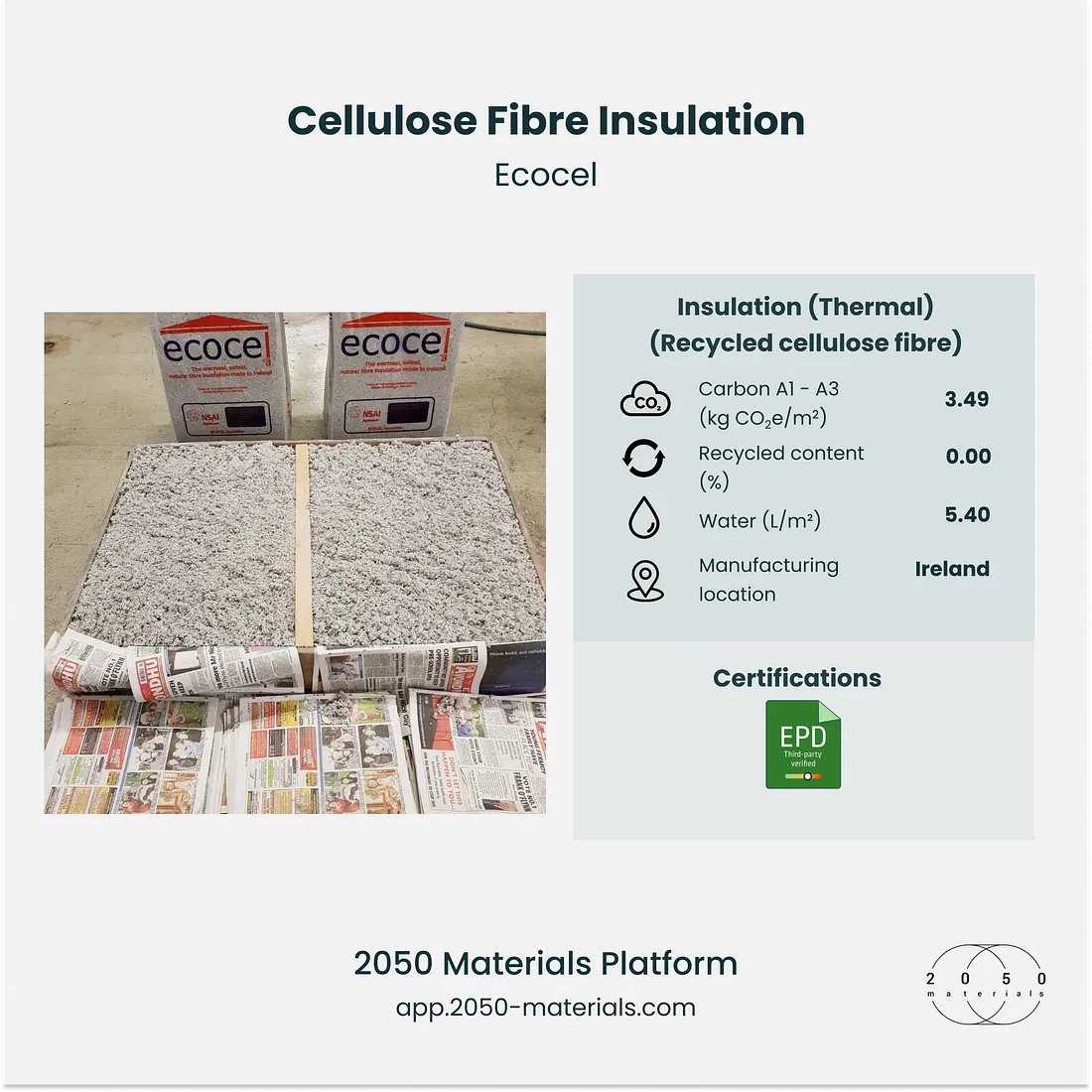
Sustainability Features
Ecocel’s cellulose fiber insulation is another option made from recycled paper products. Treated with inorganic salts for fire protection, this insulation material is safe and effective while maintaining a low environmental impact. The production process of cellulose insulation consumes less energy compared to traditional insulation materials. Additionally, its ability to control surface and interstitial condensation makes it an excellent choice for maintaining healthy indoor air quality.
Advantages
– Produced from recycled paper, reducing environmental waste
– Low energy consumption during manufacturing
– Fire-resistant due to inorganic salt treatment
– Controls condensation, improving indoor air quality
– Recyclable and biodegradable
Use Cases
Ecocel cellulose fiber insulation is ideal for use in lofts, timber frame walls, sloped ceilings, and natural stone walls. Its application through a mechanical blowing system allows for uniform coverage and effective insulation, particularly in areas where traditional insulation materials may be difficult to install.
Explore Ecocel on 2050 Materials.
5- Wood Fibre Insulation Boards: Gutex
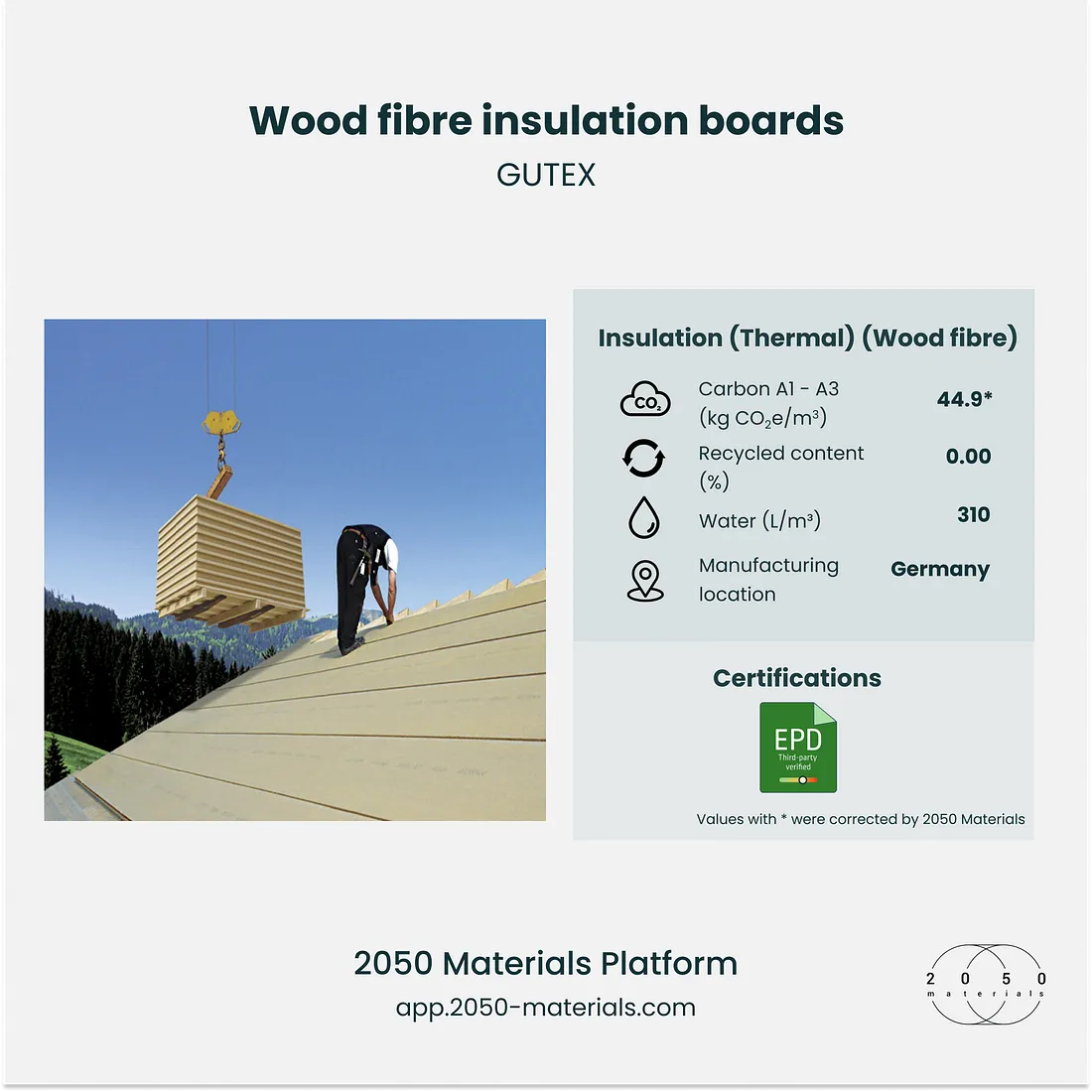
Sustainability Features
Gutex Thermofloor is a wood fiber insulation board made from sustainably sourced wood, a natural and renewable material. The product is not only recyclable but also biologically safe. Gutex Thermofloor provides excellent thermal insulation and thermal storage capacity, helping to regulate indoor temperatures naturally and efficiently, which reduces the energy demand for heating and cooling.
Advantages
– Made from sustainably sourced wood
– Recyclable and contributes to circular economy practices
– Superior thermal storage capacity
– Regulates indoor humidity and temperature
Use Cases
Gutex Thermofloor is versatile and can be used in various applications, including walls, roofs, and floors. It is especially effective in environments requiring high thermal storage and insulation, such as in regions with extreme seasonal temperature variations. Its uniform board dimensions also make installation quicker and easier, providing a practical solution for both new builds and renovations.
Explore Gutex Thermofloor on 2050 Materials.
6- Hemp Fibre Insulation: EKOLUTION AB
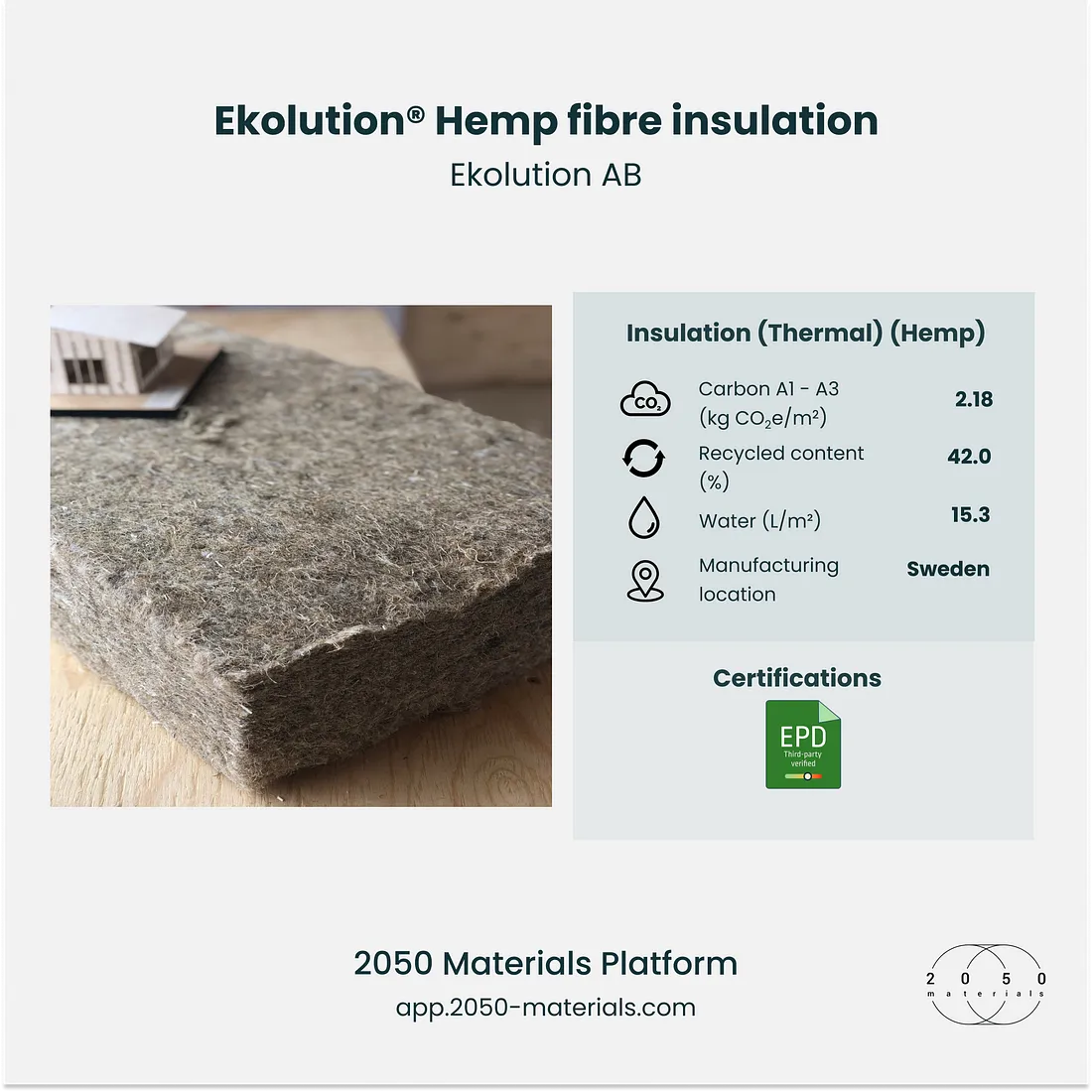
Sustainability Features
Hemp fiber insulation from EKOLUTION® is made from natural hemp, a fast-growing and renewable resource. Hemp’s low environmental impact, combined with its excellent insulation properties, makes it an ideal choice for innovative building projects. This insulation is biodegradable and can be composted at the end of its life, aligning with sustainable construction practices.
Advantages
– Made from fast-growing, renewable hemp
– Biodegradable and compostable at end of life
– Low environmental impact during production
– Excellent thermal and acoustic insulation properties
– Safe and non-toxic
Use Cases
EKOLUTION® Hemp Fibre Insulation is versatile and can be used in walls, roofs, and floors. It is particularly suitable for construction projects where sustainability is a priority. The product’s natural properties also make it ideal for use in buildings designed to promote healthy indoor environments.
Explore EKOLUTION® Hemp Fibre Insulation on 2050 Materials.
7- Plaster Diatonite Simactive: Diasen
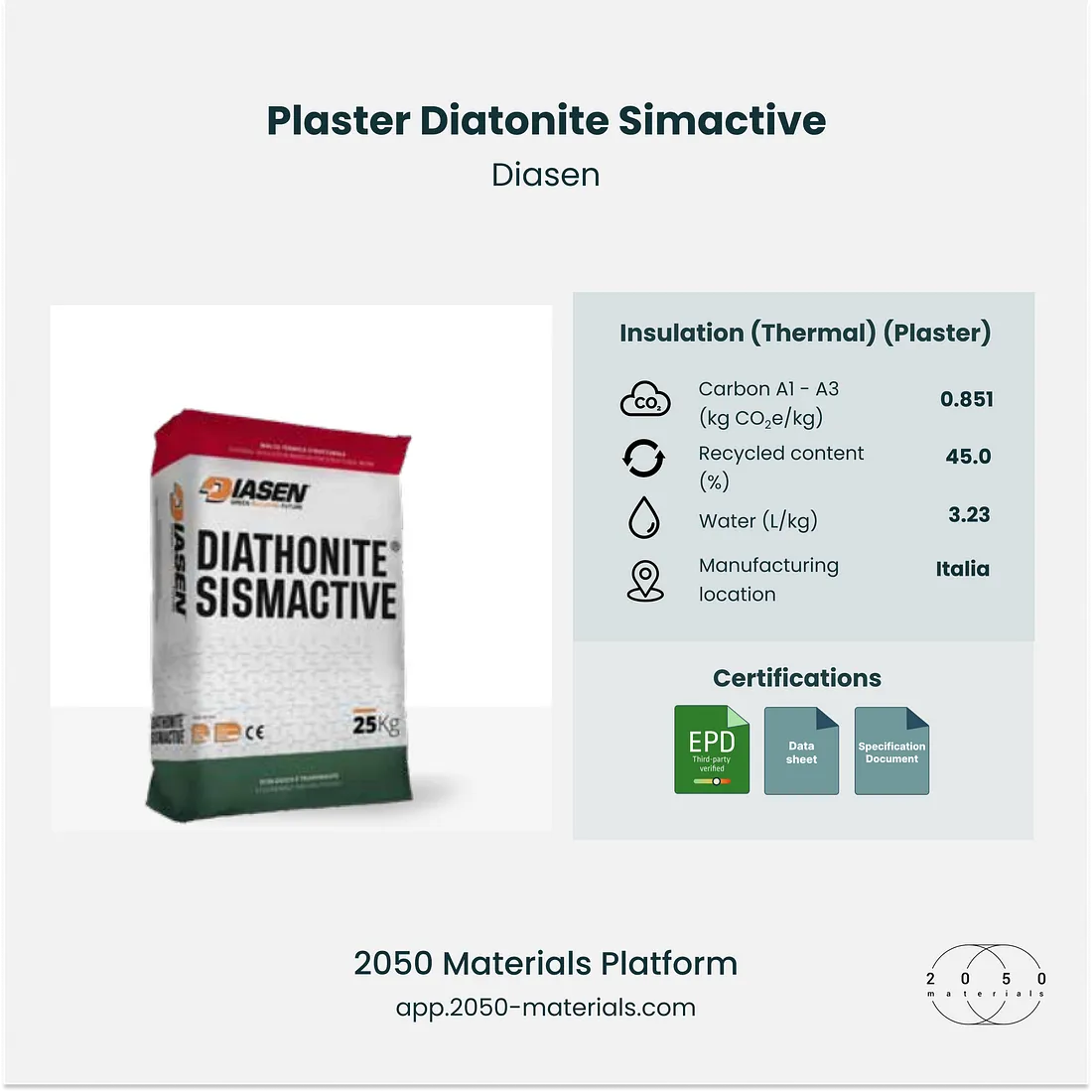
Sustainability Features
Diasen’s Cork Lime Insulation Plaster is a unique blend of cork, clay, and diatomaceous earth, offering a natural insulation solution. This plaster is highly breathable, contributing to the regulation of indoor humidity levels, which enhances indoor air quality. Its natural composition and biodegradability ensure minimal environmental impact, while its fire-resistant properties provide additional safety.
Advantages
-Made from natural and renewable materials like cork and clay
– Highly breathable, improving indoor air quality
– Biodegradable
– Fire-resistant, enhancing building safety
– Versatile and easy to apply
Use Cases
Diasen’s Cork Lime Insulation Plaster is ideal for use in both interior and exterior walls, providing a durable insulation solution that also contributes to the aesthetic appeal of buildings. Its breathability makes it particularly suitable for older buildings or those in humid climates, where moisture regulation is essential.
Explore Diasen Plaster Diatonite Simactive on 2050 Materials.
8- Straw Panels: EcoCocon UAB
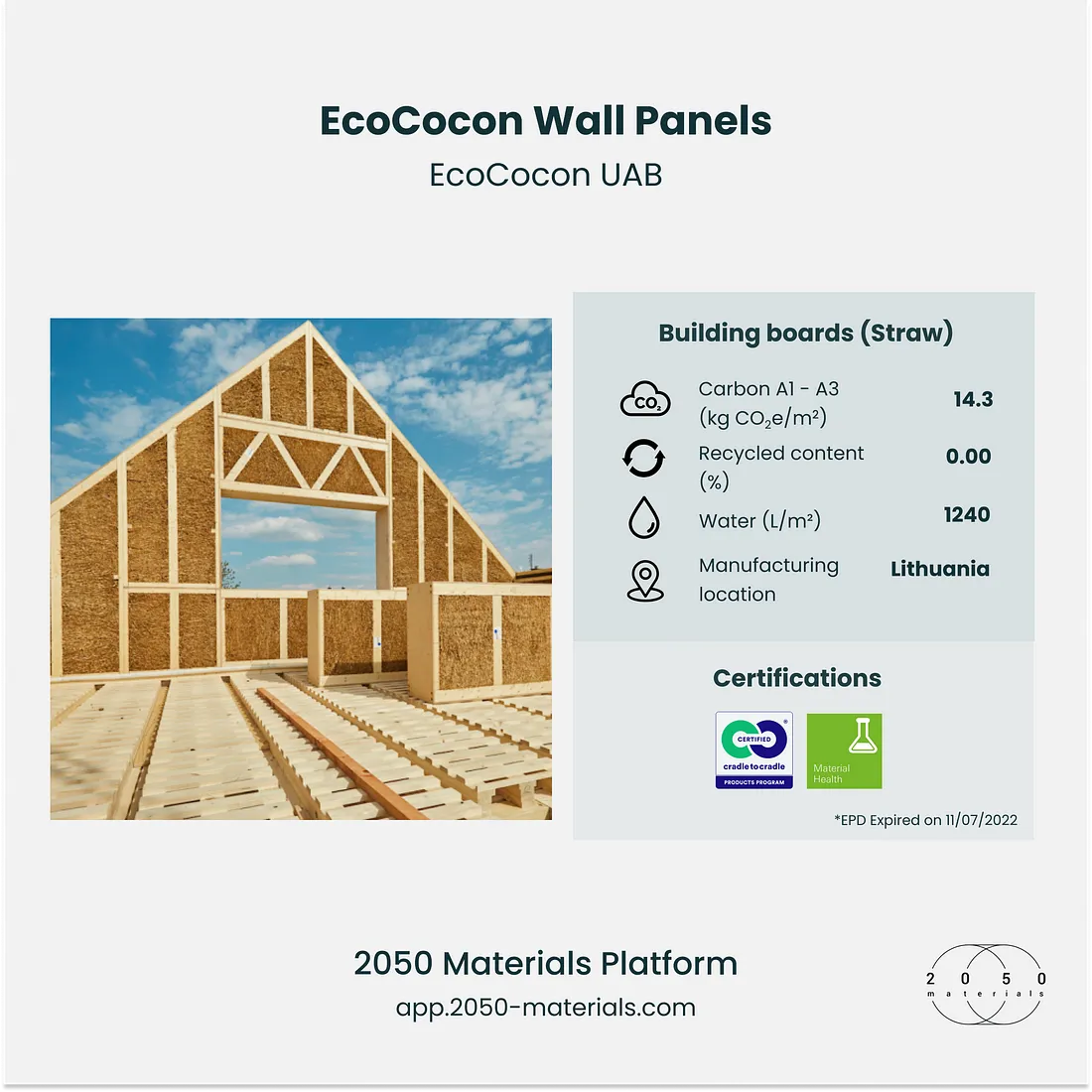
Sustainability Features
EcoCocon Wall Panels are made from natural straw, a renewable and biodegradable material. Straw panels are not only effective insulators but also have a low environmental impact due to their natural origin and the minimal processing required. Additionally, these panels contribute to carbon sequestration, as the straw used in the panels absorbs CO2 during its growth.
Advantages
– Made from natural, renewable straw
– Biodegradable and environmentally friendly
– Contributes to carbon sequestration
– Excellent thermal insulation properties
– Promotes healthy indoor environments
Use Cases
EcoCocon Wall Panels are suitable for use in walls of residential and commercial buildings. They are particularly effective in sustainable construction projects focused on reducing carbon footprints. The natural insulation properties of straw also make these panels ideal for buildings in both hot and cold climates, where thermal regulation is crucial.
Explore EcoCocon Wall Panels on 2050 Materials.
Insulation Guides on 2050 Materials
If you are interested in knowing more about the carbon and thermal performance of insulating products as well as their classification per resource origin then you would probably appreciate the Illustrated Guides to Insulation Materials we released, offering visual guides to understand the variety of insulation materials, their carbon and thermal performance and their classification per resource origin.

Conclusion
This article provides an overview of some of the most innovative insulation products available today. Each of these materials offers unique benefits, from renewable resources to low embodied carbon, making them excellent choices for builders and architects looking to minimize carbon impact in their projects. By choosing products from this collection, we can all contribute to a more energy-efficient future.
Related articles

Climate-Resilient Materials for the Built Environment: A Data-Centred Prime
As climate volatility intensifies, resilience metrics are fast becoming as critical as carbon data in material selection. This article outlines why adaptation is now a design imperative, how materials can be evaluated through a systems lens, and what KPIs project teams should demand. From self-healing concrete to fire-rated façades, we present a structured taxonomy of resilient materials, explain how to embed this intelligence into digital design workflows, and propose next steps for specification, benchmarking, and procurement.
Read more
The Most Interesting Low Carbon Products in Office Design
In this article and collection, we highlight 11 outstanding products that contribute to a lower carbon footprint in office design.
Read more
Top Low Carbon Building Boards: Performance, Benefits, and Use Cases
The building boards highlighted in this article and collection showcase low-carbon innovation in modern construction.
Read more